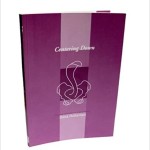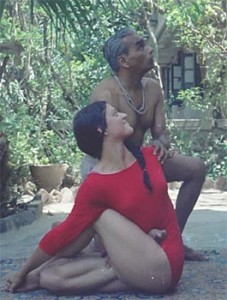“Centering Down” is a Quaker expression referring to the act of becoming quiet, still, and silent, so as to be open to receive inspiration from the Divine. In the Quaker tradition, there is no priest, rabbi or minister because the belief is that we all have the spark of Divinity within ourselves and do not need a religious intermediary. In Quaker meetings of worship, members sit in silence, holding presence, and any member, if so inspired, may rise and speak. Kate and I were married at the Haverford Friends Meeting outside Philadelphia, and it was quite fun when the guests, after sitting in silence, most unfamiliar with Quaker traditions, finally realized they could stand and speak. There was a lot of heartfelt and playfully competitive back and forth between our west coast and east coast friends. The whole experience was a real time example of the two spiritual instincts merging in a flow of love and joy.
Centering Down is also the title of a book written by Dona Holleman in 1981. As a teenager, realized she wanted to study yoga, and her mother, a student of Krishnamurti,  suggested she ask K for advice. She went to Switzerland, told Krishnamurti her desire, and he tells her; ” there is a yoga teacher from India living here and teaching me. I’ll introduce you.” Thus Dona became one of B.K.S. Iyengar’s first European students.
suggested she ask K for advice. She went to Switzerland, told Krishnamurti her desire, and he tells her; ” there is a yoga teacher from India living here and teaching me. I’ll introduce you.” Thus Dona became one of B.K.S. Iyengar’s first European students.
I met Dona in 1981, just as Centering Down came out, and immediately became inspired and impressed with her approach to yoga. She was super dedicated, with a precisely organized practice schedule, morning and afternoon sessions, timed with two different watches. Her poses were gorgeous and effortless, her teaching clear and precise.
And she also had a spiritual side that was very different from any  of the other Iyengar teachers of the time. She quoted Yaqui shaman Don Juan from Carlos Castaneda’s writings. And she talked about the Quaker tradition of centering down into silence, and embodying this in the hara. In my yang youthful enthusiasm, I missed the part about silence. This morning, in wanting to develop the heart and hara theme from the previous post, I opened “Centering Down” and came across this quote:
of the other Iyengar teachers of the time. She quoted Yaqui shaman Don Juan from Carlos Castaneda’s writings. And she talked about the Quaker tradition of centering down into silence, and embodying this in the hara. In my yang youthful enthusiasm, I missed the part about silence. This morning, in wanting to develop the heart and hara theme from the previous post, I opened “Centering Down” and came across this quote:
“Soon we realize that we have to start ‘practicing silence’ instead of waiting for chance moments in our daily life. We must find a space and set a regular time to practice the art of sitting in silence, to allow ourselves to forget everything and approach our center within.” This comes at the end of the book, after many detailed instructions on alignment and practice in the various types of asana. Dona then continues with instructions in step by step somatic meditation, releasing layers of tension until, with grace, the Ground of Being reveals itself as unbounded ultimate mystery. It is a wonderful book, still available on Amazon.com.
Dona’s embodiment of the hara was profound and clear as her quick assimilation of Iyengar’s teaching shows, and in ‘Centering Down’ she offers the following observations on the this key area, and yoga. (My comments follow in italics)
DH: The sacrum is the holy bone: the lower abdomen (between navel and pubic, and bone) should be in contact with the sacrum. Where they meet within the pelvic bowl is Svadisthana Chakra (self-energizing earth center), or Hara. This is the center of gravity.
AK: The lower abdomen includes the points CV 2 through CV-7 on the Conception Vessel. Jeffrey Yuen says that we tend to feel more at home in one of these six points. Explore how you feel in this area, using your fingers to bring more sensitivity.
DH: Hara is the rock on which we build the temple of the body. Those who are centered in the chest have too much ego and those centered in the head have too much intellect. The chest and head must rest on and be stabilized in the center of gravity.
AK: Hara is the rhythm section of the body, the bass and drums of our inner and outer dancing. The African term “Get Down”, which has taken on many meanings in pop culture, usually involving dance or sex, originally referred to “a dance, posture or movement, involving the act of bending at the waist and knees, bringing the body low to the ground in moments of ecstasy or intensity. This was an expression of profound spirituality and connectedness to the earth”.
DH: In Tadasana and all other postures, the only parts which should uphold the body are Hara and the spine ‘growing’ out of the pelvis. The energy of the rest of the body, especially the energy of the head, shoulders, chest and diaphragm, should be withdrawn and transferred to these two parts. The skeletal body should be completely firm and straight, the pelvis and spine should never sag, but the muscular body should be empty. Hara is the earth center: from here the coccyx and legs “grow” downward as roots while the spine ‘grows’ upward, each vertebrae rising away from the one below.
AK: This was written 40 years ago when our sensitivity to the subtle fluid body was less articulated, especially in the yoga world. From the stability of the Hara, the spine awakens and learns to rise up from the release of not only the yang skeletal muscles, but the awakened qi of the organs, connective tissues and blood vessels connected to the spine.
DH: The body is a self-healing organism. Yoga serves to remove unconscious tensions, stiffness and blocks in the flow of energy (Qi), all obstacles to self healing.
DH: Yoga is to silence the body, mind and heart. A silent body is a body that has natural dignity.
Practice: The Structure Supporting the Hara
We now spiral back from the interior of the torso of the previous blog and rediscover the intelligence of the bones, especially the pelvis, legs, sacrum and coccyx. The key to awaken this area structurally is ‘double action’, where we simultaneously create two opposing actions to open joint spaces. The first will be the double action opening the hip joints.
Opening the Hip Joints
Human hip joints, like most mammals, primarily flex and extend, as this is where we find the speed and power to move. In most positions, including standing, the pelvis flexes and extends over the stable femur heads. However, there are positions where we can flex and extend the femur heads over the stable pelvis. We want to learn to flex and extend simultaneously to create a dynamic stillness the creates space in the hip joints. This double action has been helping me keep my dysfunctional hip from totally collapsing.
The easiest way to feel this action in the hips is to imagine-create-feel two opposing circular movements, one of the femur head, the other the acetabulum. This is the primary action in tadasana, the foundation pose for all other asanas.
In a simple standing forward bend like uttanasana, begin in tadasana by stabilizing the feet through K-1 and the heels. Then, as if sitting into a chair, move the femur heads backwards and downwards in a circular manner. Feel this all the way into the heels and recognize the is the same circular direction as GV-1 to CV-1, or ‘tucking’, up the front – down the back to the heels. To complete tadasana, remain extending upright with the pelvis lifting up off the femurs, but create the opposite action around the acetabulum, CV-1 to GV-1. This will create a nice release at the bottom of the groins that you will feel down to K-1, without tilting the pelvis forward.
To come into uttanasana, maintain the femur action, create the opposite at the acetabula, but now let the pelvis rotate, coming around the corner and down. As the pelvis begins to move, maintain the opposite femur action. (Always double action, especially in movement.) Feel this down the front into K-1, in the circular action of CV-1 to GV-1 or ‘untucking’, and up the back, lengthening the hamstrings up to the sitting bones. Keep the knees firm without hyper-extending. Continue both circles as you remain in uttanasana and then drop into stillness as the two energies balance in sthira sukham.
To come back to tadasana, reverse both circular actions; heads of femurs down the front/up the back; sitting bones down the back/up the front. As long as you have the double action, you can reverse femurs and acetabula actions to see if one or the other is more helpful. Of course, while moving, the movement determines the pairing. Apply this action at the beginning of your sitting practice to root the hips. Integrate with the double action larger microcosmic orbit and drop into stillness. This action is crucial in every pose.
Opening the Sacroilliac Joints
I couldn’t access this file for the blog, but check out this amazing video clip to see what is being described. This lateral view (Courtesy Joseph E. Muscolino. Manual Therapy for the Low Back and Pelvis – A Clinical Orthopedic Approach (2015)), shows the movement known as counternutation of the sacrum.
To open the sacro-illiac joints, we create another double action. First is an slight/subtle anterior tilt of the illium, following the circular action of; down the front-up the back/CV-1 to GV-1/ untucking/ pelvic flexion. The we add the circular action of the sacrum, as shown above; down the back-up the front/ GV-1 to CV-1/ tucking. This is best accomplished at the bottom of the sacrum where it joins the coccxy. This is the GV-1 to CV-1 that seems to be missing in many people. Balance the two actions in every pose.
Integrating
Notice you can link sacrum and femurs with the pelvis suspended between the two. Femurs and sacrum ‘tuck’; pelvis ‘untucks’. Or the reverse. Which feels better for you. Try this in sitting. Feel how it activates the hara. Link it to the micro-cosmic orbit as well. Feel grounded and centered, ‘centering down’. Drop into stillness and allow Being to Be.

